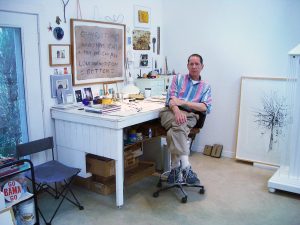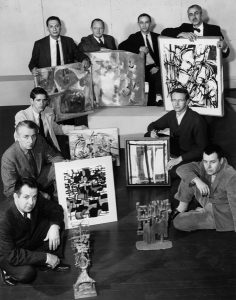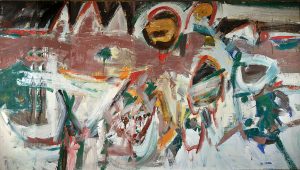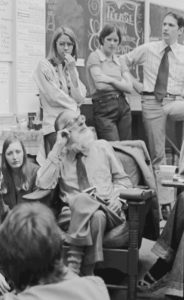We mourn the loss of a friend of the department, an alumnus and an icon of the art world, William Christenberry (1936-2016). Below is an interview with him that originally appeared in the fall 2009 issue of The Loupe.

Editor’s note, fall 2009 — William Christenberry (BFA 1958, MA 1959), an internationally renowned artist and alumnus of The University of Alabama Department of Art and Art History, will lecture on his art on the UA campus on November 5. An exhibition of his works at the Sarah Moody Gallery of Art will be on view from November 5 through December 22, 2009. This year is the fiftieth anniversary of his receiving the Master of Arts degree in art from the University. In anticipation of his visit to campus, Mr. Christenberry and I recently talked on the phone from his home in Washington, D.C., about a wide variety of subjects. He has a very relaxed style of speaking, as if he never left the dusty porches and kudzu jungles of west Alabama. His dry sense of humor and gentle spirit are sometimes difficult to convey in writing, but were ever-present in our conversation. —Rachel Dobson
William Christenberry entered The University of Alabama as a freshman in 1954, intending to major in commercial art. “I didn’t know any better,” he laughs. But his teachers’ observations of him, and his own instincts, steered him in another direction.

Christenberry said that Jack Granata, Howard Goodson, Melville Price, Lawrence Calcagno, a visiting artist from the West Coast, and Frank Engle, from whom he only took one class, influenced him toward the fine arts. In Engle’s class, he didn’t make pots, but fashioned ceramic figures that he sees as connected to his later Klan pieces. Christenberry credits art historian Joe Bolt, who taught him drawing his freshman year, with “predicting” he would be a painter, not a commercial artist.1 Granata, Price, and Goodson he later counted as friends, as well as influential teachers. “Mr. Granata was a wonderful teacher and a wonderful friend,” he recalled. “I identified very closely with Howard Goodson because he was from Alabama, from a small town — Vernon, I think — and he was real special to me.” He remembers Ted Klitzke, who came in as chair in 1958, as “solid as a rock and a true gentleman.”
Christenberry recalls the atmosphere around the department when he was in school from 1954 through 1959. “All the faculty were very active, doing their own studies. A lot of that excitement was coming out of New York, with Abstract Expressionism, which was a vital movement at that time.”
During his school years, however, Christenberry began to find his own voice, and “to deal with subject matter, but in an expressionistic way,” as he puts it. About his paintings, he said, “They’ve got all that gesture. I’ve always loved surface, texture, painting, thick paint. But, I wanted to use again the subject matter that I was familiar with, that I grew up with, that I cared so deeply about.”

When he was a boy, one Christmas Santa Claus gave him a Brownie camera, but it wasn’t until he was in school at the university that he began using it. “I went into that landscape, in Tuscaloosa and Hale counties primarily, and began to photograph the things that caught my eye, the vernacular architecture in particular, the country graveyards, which were beautiful things. I used to haunt country graveyards…just to feed my spirit.”
In Working from Memory, his most recent publication, he talks about how the Brownie camera — and the landscape of west Alabama — helped him move from pure Abstract Expressionism to his own painting dialect:
“Abstract Expressionism was all the rage in the art world then, and just like everybody else I was painting in that style. I was coming to grips with my feelings about the landscape and what was in it, though, so I incorporated objects or places into my paintings, such as graveyards and tenant houses. I would take color photos with the Brownie of anything that caught my eye, send them to the local drugstore to be developed and use the photos as color references for my paintings in the studio.”2
He had already been photographing around west Alabama when another event steered Christenberry toward his unique painting vernacular. He discovered the book, Let Us Now Praise Famous Men by James Agee and Walker Evans when it was reissued in 1960. “[It] made a tremendous impression on me.” It was actually Agee’s writing that had more of an impact on Christenberry than Evans’ photographs. “See, Agee was a fellow southerner, he was from Knoxville Tennessee, or born there. That was, and is still considered — this is not just my opinion — one of the best collaborations between a visual artist — Walker Evans, and a writer — Agee. What Agee was doing with the written word is what I wanted to do with paint. Not literally, but in terms of feeling.”

Christenberry recalled that one of the “wonderful” things about the department is that they brought in visiting artists from all over. “It didn’t get stale.” Lawrence Calcagno (1913-1993), an Abstract Expressionist painter from San Francisco, was one of those visiting artists. Christenberry describes Calcagno’s painting style as lyrical abstraction, which provided a counterbalance to Mel Price’s style of Abstract Expressionism. Price and Calcagno were also very different personalities, which Christenberry recalls helped him develop different sides of his own artistic self. “[Calcagno] was a very gentle-type man, very soft spoken, very bright. Mel was very brash, opinionated, and outspoken. But I loved them both.”
Melville Price, who came to Alabama from New York in 1958 and taught art until his death in 1970, had a lasting influence on Christenberry. “He could be gruff; he could express his opinion. He latched on to me and I latched on to him and we had some interesting tussles. He was very significant to me.”

Price helped put Christenberry in touch with the outside art world before and after he graduated. When he took a trip to New York as a student, Christenberry and his friend Peter Thomas (who later became Dean of the Corcoran School of Art, and then head of the Graphics Department of the Federal Reserve) took with them a letter of introduction from Mel Price to Price’s friend, the artist Franz Kline. They tried tracking Kline to his favorite bar in Greenwich Village, the famous Cedar Tavern, where Kline and his artist friends hung out. Christenberry didn’t shrink from telling a story on himself about stalking the artist in the city. “I didn’t have any money. I nursed one beer. I was shaking in my boots. The bartender just let me sip it; I’m not a big drinker, anyway. Finally he said, ‘you’re just ‘bout out of luck, son. Franz comes in here every night and he hasn’t been here one night since you came here.’”
Later they went to Kline’s studio, and opened the mail slot to slip in the letter of introduction. “I lifted that little flap and you could see these wonderful big black and white paintings all over the place.”
At UA, Christenberry accepted an instructorship in the department when he graduated and stayed about a year — and might have stayed longer. “Mel was very supportive of my painting, and as time went on, he said to me, ‘you know you should move on and see something of the rest of the world — don’t get stuck here.’ That was not a criticism of the university, but pushing a young person out into the world.”
Christenberry took Price’s advice and moved to New York. Artistically it was not the most productive year for him, but in the big city he found influences, made decisions, and met people that would figure significantly in his artistic life to come.

The other artist he tracked down in New York was Walker Evans. “I finally got up enough nerve to call up Fortune magazine where Evans worked. I probably made a fool of myself. But he was very, very kind and gentle, and when I finished my off-the-wall diatribe, he wanted to know what did I do, why was I in New York?” Evans listened to Christenberry and then asked to see his snapshots. The young artist hesitated to show them because he had made them for himself, for reference purposes only. But Evans insisted on seeing them. “I was as nervous as all get-out. He went through them one by one.” Finally Evans told him, “‘Young man, that little camera has become a perfect extension of your eye, and I suggest you take these seriously.’” Evans and Christenberry eventually became friends, and traveled to Hale County together in 1973. [Editor’s note: See photo by Wayne Sides at left. During that 1973 trip, they visited the photography class of newly hired photography professor Gay Burke at UA. In attendance was Wayne Sides, who shot this photo, and Janice Hathaway, both now renowned photographers in their own right.]
Christenberry’s life’s work is not only the art pieces he imbues, in all their rich forms of painting, sculpture, assemblages and photography, with the essence of the Black Belt landscape. It is also the embedding of that landscape into his and his family’s psyche. He and his family have rarely missed a year of their annual return to west Alabama, to visit his parents’ families and the land where they lived, for the same reasons he visits country graveyards, “just to renew my spirit.” “I didn’t know that earth, that red dirt — what an effect it would have on me.”
“The time spent with grandparents on both sides was very, very important in my life…I have nothing but fond memories of that — grandfathers and grandmothers would tell stories, wonderful stories. Most Southerners are pretty darn good storytellers. I didn’t realize at the time what an impression that tradition would have on me later. ‘Cause I like a good story. I like to think that once in a while I can tell a good story.”
1 J. Richard Gruber, William Christenberry — The Early Years, 1954-1968 (Tuscaloosa: The University of Alabama Press, 1998), 15.
2 William Christenberry: Working from Memory — Collected Stories, S. Lange, ed. (Göttingen, Germany: Steidl Publishers, 2008), 14.